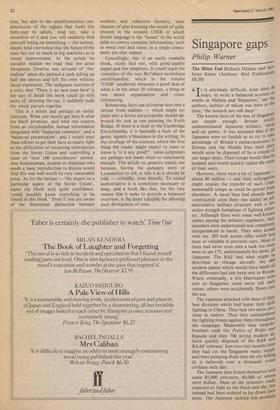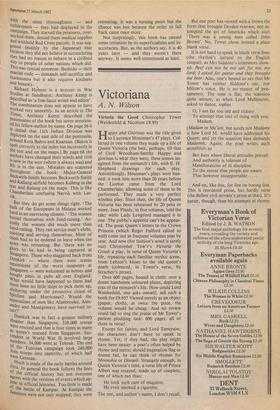Singapore gaps
Philip Warner
T t is extremely difficult, even after 40 lyears, to write a balanced account of events in Malaya and Singapore,' say the authors, neither of whom was born at the time; 'the wounds are still deep.' The known facts of the loss of Singapore are simple enough. Britain totallY underestimated Japanese military, fla' and air power. It was assumed that if the Japanese were so foolish as to try to take advantage of Britain's embarrassments in Europe and the Middle East their navY would soon be disposed of by a couple of our larger ships. Their troops would then be isolated and would quickly realise the error of their ways.
However, there were a lot of Japanese -- about 80 million — and their subjugation might require the transfer of such Com- monwealth troops as could be spared from elsewhere. A naval base had already been constructed: soon there was added an ad- ministrative military structure with a few under-strength battalions of fighting infan' try. Although there were some well-known names among the infantry regiments, their members were undertrained and completely inexperienced in battle. They were anted, with the .303 bolt action rifles which had been so valuable in previous wars. Most of them had never even seen a tank but soon were to see 175, unfortunately for them, all Japanese. The RAF had what might be described as vintage aircraft: the 02 modern planes which would have made an the difference had just been sent to Russia. When, eventually, a few Hurricanes Were sent to Singapore some never left their crates; others were accidentally flown into the sea. The Japanese attacked with three of their best divisions which had learnt their skills fighting in China. They had two more divi- sions in reserve. Thus they outnumbered the fighting troops against them throughout the campaign. Meanwhile their torpedo- bombers sank the Prince of Wales and Repulse and their 700 strong modern air, force quickly disposed of the RAF and RAAF veterans. Just over two months later they had cut the Singapore water supply and were pumping shells into the city killing (it is believed) over a thousand Asian civilians each day.
The Japanese then found themselves with some 85,000 prisoners, 60,000 of whom were Indian. Most of the prisoners reallY expected to fight to the finish and die, but instead had been ordered to lay down their arms. The Japanese tackled this problem with the same thoroughness — and ruthlessness — they had displayed in the campaign. They starved the prisoners, over- worked them, denied them medical supplies and withheld Red Cross parcels. It was sug- gested (mainly by the Japanese) that because they did not believe in surrendering they had no reason to behave in a civilised waY to people of other nations which did. This was cynical nonsense. Bushido — their martial code — demands self-sacrifice and fearlessness but it also requires kindness and honesty.
Richard Holmes is a lecturer in War Studies at Sandhurst; Anthony Kemp is described as 'a free-lance writer and editor'. The combination does not appear to have worked very smoothly. In an article in The Times, Anthony Kemp described the Pretensions of the book but never mention- ed his fellow-author by name. On page 56 it is stated that 11th Indian Division was deployed on the east side of the peninsula, around Kota Bahru and Kuantan. (Bahru is spelt correctly in the index but incorrectly in the text and on the maps.) By page 68 the authors have changed their minds and 11th is now in the west (where it always was) and 9th is in the east. Mistakes are scattered throughout the book: Major-General Beckwith-Smith becomes Beckworth-Smith and Kallang airfield becomes Kalleng in the text and Kalang on the maps. This is like Chamberlain confusing Narvik with Lar- vik.
But they do get some things right. 'The bulk of the Europeans in Malaya worked hard in an enervating climate.' The women busied themselves with fund-raising.' Ac- tually the women did much more than fund-raising. They ran service-men's clubs, cooking and serving themselves. Most of them had to be ordered to leave when the army was retreating. But 'there was no glory to be had in being captured at Singapore. Those who staggered back from Dunkirk — where there were scenes reminiscent of the worst moments at Singapore — were welcomed as heroes and bought pints in pubs all over England. What would have happened to them had there been no little ships to pick them up, sheltering under the protective cloud of Spitfires and Hurricanes? Would the reputations of men like Alanbrooke, Alex- ander and Montgomery have survived in-
tact?'
Dunkirk was in fact a greater military disaster than Singapore. 338,000 troops were rescued and that is four times as many as weren't rescued from Singapore. Sur- renders in World War 11 involved large numbers. 34,000 went at Tobruk. The end Of the Tunisian campaign took 240,000 Axis troops into captivity, of which half were German.. Much is made of the early battles around Jitra. In general the book follows the lines Of the official history but not everyone agrees with the versions of events which ap- Pear in official histories. Too little is made of the battle of Kampar. At Kampar the Japanese were not only stopped; they were
retreating. It was a turning point but the chance was lost because the order to fall back came once more.
Not surprisingly, this book has caused some irritation by its superficialities and in- accuracies. But, as the authors say, it is 40 years later — and they weren't there anyway. It seems well-intentioned at least.





































 Previous page
Previous page